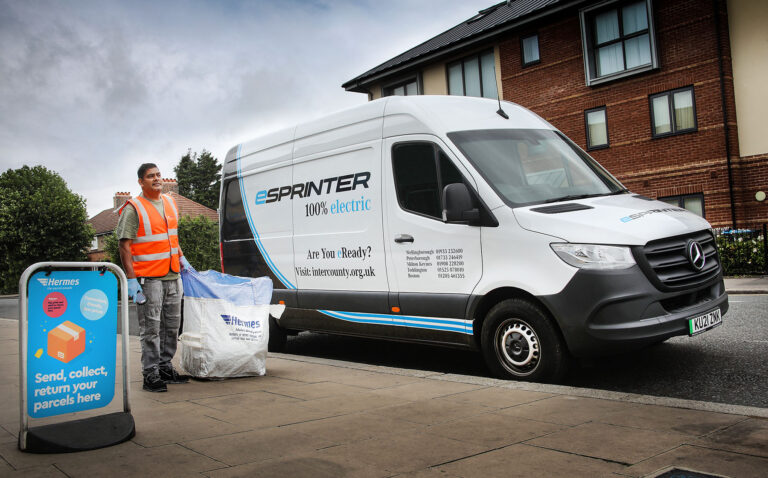Consumer parcel delivery specialist Hermes has underscored its commitment to an emissions-free future by placing a huge order for 168 fully electric Mercedes-Benz eSprinters.
The zero-emission vans should all be on the road before the end of the year. They will be assigned to Hermes’ popular ParcelShops service, which operates from more than 5,000 convenience stores and other locations nationwide.
Hermes has commissioned Pod Point UK to install charging points at its network of depots. This work is already underway, with the focus initially on those in London and other cities that have introduced low emission zones.
Hermes plans to undertake all ParcelShop collections with electric vehicles at the earliest opportunity. The company has only ordered the diesel vans to ‘tide it over’ pending completion of its infrastructure programme and the introduction of next-generation battery-powered variants.
The company relies on a core fleet to service its ParcelShop business. This currently stands at some 450 units but is growing, and supplemented with rented vehicles during busy periods. The owned fleet includes 30 smaller electric vans that work from a depot in East London, while French-built diesels will be stood down to make way for the eSprinters.
“The transition to a zero-emission, electric fleet is integral to our ESG (environment, social and governance) agenda, and we’ve been keen to take the next, major step forward towards this goal,” said David Landy, Hermes Head of Fleet.
“However, we are under no illusions… this will not be an easy journey. From a purely operational standpoint, and given the current state of the technology, whichever way you look at it – whether in terms of range, payload or volume – a van with an internal combustion engine beats an electric one hands down.
“Only when it comes to tailpipe emissions does the battery-powered vehicle outshine the diesel. So we know there are constraints and compromises to make, and we recognise that this is going to put extra pressure and increased demands on those colleagues out in our depots who are doing a difficult job, day in, day out.”
“We’re at the very beginning of what is going to be a long and challenging process,” continued Landy. “This is new technology, so product support will be crucial. There are electric vans out there that offer a longer range than the eSprinter, but any electric vehicle is going to break down, and it’s going to do so in new ways too.
“When that happens we want to know there’s an army of people out there who are fully clued-up and able to get us back on the road as quickly as possible. Mercedes-Benz Vans gives me that confidence.
“It’s reassuring to know that we’re starting out on this journey with the backing of the right people, a global manufacturer that will help us to overcome operational hurdles as they arise, and Dealers who appreciate the importance of restricting vehicle downtime to an absolute minimum.”
The Mercedes-Benz eSprinter is powered by a 114 hp electric motor that drives the front wheels. It will travel 95 miles (combined WLTP with 80 km/h speed limiter) on a single charge, which is ample for the majority of urban delivery and last mile applications; recuperative energy recovered when decelerating supplements the batteries’ output.
The vehicle is based on the L2 (medium length), H2 (high roof) Sprinter. Its 55 kWh high-voltage battery pack is securely mounted beneath the body, so does not impinge on cargo carrying space. As a result, the eSprinter’s 11m3 load volume is identical to that of its diesel-engined, front-wheel drive stablemate, and half a cubic metre larger than its rear-wheel drive equivalent.







